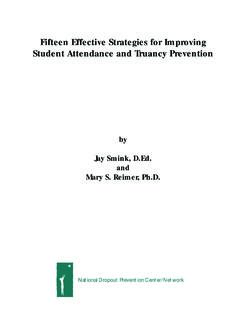Transcription of Examining Student Perception of Readiness for Online ...
1 Examining Student Perception of their Readiness for Online Learning: Importance and Confidence Online Learning Journal Volume 24 Issue 2 June 2020 5 38 Examining Student Perception of Readiness for Online Learning: Importance and Confidence Florence Martin, Brandy Stamper, and Claudia Flowers University of North Carolina Charlotte Abstract This survey study examined Student Readiness for Online learning in 2018 through the dimensions of importance placed by the Student in Online learning and the Student s confidence in their ability as measures of Readiness .
2 An instrument with four subscales of competencies ( Online Student attributes, time management, communication, and technical) that measure Student Readiness for Online learning (SROL) was developed. Reliability of Student responses on the Online Readiness instrument and factors related to Student Perception of Readiness were examined. Descriptive statistics and item level means for the competencies are provided. Repeated measures analyses of variance were conducted to examine differences between participants ratings of importance and confidence. Online Student attributes, time management, and technical competencies were rated high for importance compared to communication competencies.
3 students were confident in Online Student attributes and technical competencies compared to time management and communication. Data were also analyzed based on demographic differences. MANOVA showed significant differences based on the race (white and nonwhite) of the students and course format (asynchronous, synchronous, and blended) on their perceptions of Online learning competencies. Keywords: Student Readiness , Online learning, Student attitude, Student ability, Student Perception Martin, F., Stamper, B., & Flowers, C. (2020). Examining Student Perception of their Readiness for Online learning: Importance and confidence.
4 Online Learning, 24(2), 38-58. Examining Student Perception of their Readiness for Online Learning: Importance and Confidence Since 1990, Online learning has increased with higher education institutions investing considerable resources in electronic learning technologies (Collins, McKinniees, & Collins, 2010; Deng & Tavares, 2013; Moore, 2013). These technologies included Learning Management Systems (LMS) to facilitate Online courses and Online Student collaboration as well as track students ' progress (Islam, 2012). From the Online classroom to the utilization of polling software, digital e-books, and adaptive learning management systems, educational technology options are growing and have transformed how higher education institutions approach curriculum and Examining Student Perception of their Readiness for Online Learning: Importance and Confidence Online Learning Journal Volume 24 Issue 2 June 2020 5 39 learning engagement .
5 Data collected from higher education institutions found that in the fall of 2015, over six million college students ( of all higher education enrollments) were enrolled in at least one Online course and, as a result, Online course enrollments were increasing while the enrollment rates of physical campus courses were declining (Allen & Seaman, 2017). As the prevalence of Online course offerings in higher education increases, so does the need for research on factors contributing to students ' academic success in those Online environments.
6 Online courses require students to consider new ways to prepare, organize, engage, and complete requirements calling for students to utilize higher levels of independence and self-direction. This study aimed to examine Online Student Readiness for Online learning based on students Perception of the importance of and their confidence in several competencies. Review of Relevant Literature Student Readiness for Online Learning Instruments Interest in Student Readiness for distance education dates back to the mid-1990s when Biner, Dean, and Mellinger (1994) examined learner characteristics in televised college-level courses.
7 The concept of Student Readiness for Online learning was first coined by Warner, Christie, and Choy (1998). In their study, Student Readiness for Online learning was broken down into three key facets: students ' preference in course modality, Student competence and confidence in utilizing computer-mediated communication, and students ability to participate in self-directed learning. Since then, researchers have continued their efforts to measure Student Readiness in Online learning through the creation of a number of Online Student Readiness instruments (Bernard, Brauer, Abrami, & Surkes, 2004; Dray & Miszkiewicz, 2007; Kerr, Rynearson, & Kerr, 2006; Mattice & Dixon, 1999; McVay, 2001; Parnell & Carraher, 2002; Watkins, Leigh, & Triner, 2004).
8 Student Readiness has been examined over the years through a variety of constructs. Table 1 includes details about some of the information and constructs of Online Student Readiness instruments. Farid (2014) conducted a systematic review of Student Online Readiness assessment tools and evaluated the quality of instruments developed through ten studies between the years 2001 to 2008. He examined 31 e-learning constructs among the 10 instruments and found that the highest number of common constructs in these instruments was seven. This illustrates the various foci among these instruments.
9 Also, with the changing technologies and students ' different levels of prior knowledge, there was a need to examine Student Readiness over time. By reviewing the literature, several existing Online Student Readiness survey instruments and the constructs each instrument measured were identified (see Table 1). Student Online Readiness Surveys in Universities Farid (2014) surveyed 18 universities and found that many of the universities created their own self-assessment instruments to use with their students and these were not validated or published.
10 Table 2 below is a list of some existing instruments found from a Google search. Examining Student Perception of their Readiness for Online Learning: Importance and Confidence Online Learning Journal Volume 24 Issue 2 June 2020 5 40 Table 1 Summary of Existing Online Student Readiness Survey Instruments Name of Instrument Authors/Year Number of Survey Items Constructs Measured Validated by Distance Learning Survey Mattice and Dixon (1999) 25 items Student Readiness , Student assess to/use of technology, and Student interest in distance education, demographic questions Muse (2003).











